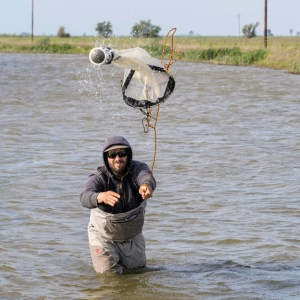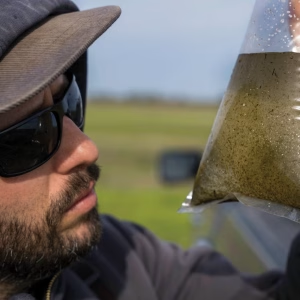In a region where water connects everything, collaboration turns that involuntary bond into meaningful action. By choosing to work together, the Floodplain Forward Coalition is bringing new life to California’s rivers and landscapes for endangered species, birds, and the communities that depend on them. The coalition brings together 35 diverse organizations representing landowners, irrigation districts, scientists, and conservation groups.
We’re proud to see our partners’ efforts featured in Comstock’s Magazine this month.
Learn more about the coalition here and explore how it works in practice through local projects across the region.
This collaborative work has also helped inspire California’s Healthy Rivers and Landscapes Program, a forward-looking approach to managing water for both environmental health and community resilience for all of California.
Read an excerpt from the Comstock’s feature below or view the full article here: This Collaboration Between Farmers, Water Officials and Environmentalists Is Saving Wildlife

This Collaboration Between Farmers, Water Officials and Environmentalists Is Saving Wildlife
By Brad Branan, Comstock’s Magazine

Water policy in California is defined by fighting. Water agencies, farmers, cities and environmentalists argue over every last drop available in the state’s overdrawn water system. Plans to fix the system languish for decades, and if they’re implemented, they end up in court for many more years. The Floodplain Forward Coalition has broken out of that paradigm.
Floodplain Forward brings together conservation groups such as Audubon, California Trout and Ducks Unlimited, agricultural interests such as the California Rice Commission, water providers and other interest groups to work on some of the state’s biggest water problems. Members of Floodplain Forward say the stakes are high in the effort to address issues such as habitat loss for fish and waterbirds.
To take one high-profile example, the endangered status of the Chinook salmon has led state officials to consider reducing agricultural and municipal water use on the Sacramento River watershed to provide more water for fish.
Gov. Gavin Newsom has advocated greater cooperation generally and the work of Floodplain Forward specifically as he pushes his water agenda. The State Water Resources Control Board in July made his proposal, called the Healthy Rivers and Landscapes Program, a centerpiece of the draft Sacramento River watershed plan. The program builds heavily on the work done by Floodplain Forward.
“I am proud to see the Healthy Rivers and Landscapes Program represented in this plan update — it’s a testament to California’s commitment to a collaborative, science-driven approach to managing our water for the benefit of our communities, economy, and fish and wildlife, ” Newsom said in a July news release.
Floodplain Forward uses a spirit of cooperation and cutting-edge science to improve the health of salmon, other fish and waterbirds. Farmers need better environmental outcomes to keep the water flowing to their fields. They also benefit by receiving payments for use of their land.

The idea for Floodplain Forward came out of a growing awareness of the problems caused by the development of the Sacramento River watershed, says David Guy, president of the Northern California Water Association, which has taken the lead in directing the group’s efforts. Levees and dams were built to collect water, stop catastrophic flooding and allow the development of cities and farms. The work helped the region grow but also dramatically reduced fish and bird habitat.
Guy points to the work of Peter B. Moyle, professor emeritus at the Center for Watershed Sciences at UC Davis, for providing the research that helped stakeholders understand the impacts. The Center for Watershed Sciences is part of the Floodplain Forward Coalition. One of Moyle’s previous students, Jacob Katz, is now senior scientist at California Trout and putting those ideas to use.
The Sacramento and other rivers once flooded a much greater area, providing fish with more nutrients, Katz says. “The food used to be on the landscape,” he adds. Now, restricted to narrow river channels, fish are deprived of essential nutrients.
California Trout has teamed with rice farmers to put water back on the floodplains. The fields are flooded after harvest, attracting bugs. The fields are drained, with the bug-rich water going through channels and into the Sacramento River, where they provide nutrients for salmon and other fish.
Once they understand the ecology, farmers and other stakeholders embrace the idea of putting water back on floodplains, Katz said. The alliances created by Floodplain Forward have surprised some political insiders. “We went to Washington, D.C., a fish guy, a water guy, a farmer and a bird guy. These congressional staffers, their eyes just bugged out, like, ‘What is going on here?’” says Katz.
“The magic of Floodplain Forward is the collaboration,” says Tim Johnson, president and CEO of the California Rice Commission. “You’re either part of the solution or part of the problem, and rice farmers want to be part of the solution.”
Young salmon are very small when they leave their nesting areas on tributaries of the Sacramento River. Many of them don’t make it through the Sacramento-San Joaquin Delta because of problems with the troubled estuary, including water diversions, pollution and rising temperatures. Katz and others hope that fattening up the fish will make them better prepared to handle the threats of the Delta and make it into the ocean before returning to their birthplace in the natural life cycle of salmon.
Another way to better feed the fish is to direct them to flooded floodplains where they can take advantage of the additional food and grow before resuming their journey to the sea. Katz and others conducted a study on a rice farm on the Yolo Bypass to determine the effectiveness of the strategy. Young salmon were placed on a flooded rice farm after the autumn harvest. They were marked and measured during a six-week period before being released.
“The overall rapid growth and robust body condition of the salmon in this study demonstrates that winter flooding of rice fields during the agricultural non-growing season can provide high quality habitat for rearing juvenile Chinook salmon,” the authors wrote in the 2017 peer-reviewed study.

A recent project by River Partners, a nonprofit that is part of Floodplain Forward, brings fish onto the floodplain. River Partners considers the Willow Bend Preserve, located near Colusa about an hour north of Sacramento, a model for salmon recovery. The 175-acre property on the Sacramento River floods often, which made it hard to turn a profit when it was a farm.
The flooding often put fish on the land, but there was no effective way for them to get back in the river. After purchasing the property, River Partners enlisted Cal Poly San Luis Obispo to design a “fish gate” that allows fish to move on and off the preserve when it floods, says Alex Karolyi, a River Partners spokesperson.
River Partners has observed young salmon using the fish gate during high-water events on the Sacramento River. Chinook salmon were the second leading fish observed in 2024, according to a River Partners report. They were able to eat bugs that accumulated on the property.
River Partners bought the property from farmers, as it has on other floodplain restoration projects, including Dos Rios, which recently became California’s newest state park. The founders of River Partners were farmers, which makes working with other farmers a natural fit, Karolyi says.
Continue reading on Comstock’s Magazine webpage.




